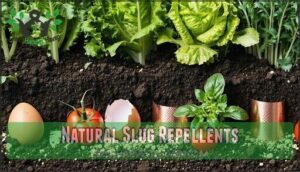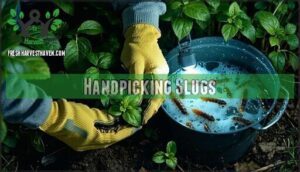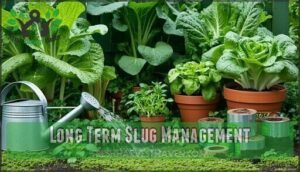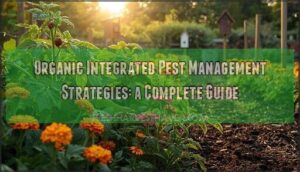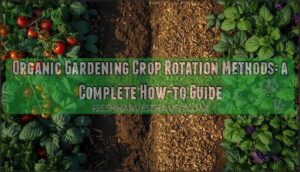This site is supported by our readers. We may earn a commission, at no cost to you, if you purchase through links.
 You can get rid of slugs using barriers like coffee grounds or crushed eggshells that feel like walking on broken glass to their soft bodies.
You can get rid of slugs using barriers like coffee grounds or crushed eggshells that feel like walking on broken glass to their soft bodies.
Spray vinegar solutions directly on slugs for instant results, or create ammonia traps around vulnerable plants.
Handpicking during early morning or evening hours when they’re most active works surprisingly well.
Remove their hiding spots by clearing debris, fallen leaves, and dense vegetation where they shelter during the day.
Natural predators like birds and beetles also help control populations.
The secret lies in combining multiple methods and understanding their nocturnal feeding patterns for maximum effectiveness, by using techniques like barriers, ammonia traps, and attracting natural predators to ultimately achieve instant results.
Table Of Contents
- Key Takeaways
- Slug Behavior Factors
- Getting Rid of Slugs
- Natural Slug Repellents
- Slug Control Methods
- Long Term Slug Management
- Frequently Asked Questions (FAQs)
- What is the quickest way to get rid of slugs?
- What do slugs hate most?
- What is the best thing to kill slugs with?
- How do slugs affect my greenhouse plants?
- Do slugs have natural predators in gardens?
- Can slugs develop resistance to deterrents?
- Are floating row covers effective against slugs?
- How long do slugs live in gardens?
- What time of year are slugs most active?
- Do slugs damage plant roots underground?
- Conclusion
Key Takeaways
- Combine multiple methods – Don’t rely on just one approach. Mix physical barriers like coffee grounds or crushed eggshells with direct treatments like vinegar sprays and beer traps for maximum effectiveness.
- Target their nocturnal activity – You’ll catch more slugs by handpicking during early morning or evening hours when they’re most active, and set up traps overnight when they come out to feed.
- Remove their hiding spots – Clear away fallen leaves, debris, and dense vegetation where slugs shelter during the day. This forces them into the open where your control methods work better.
- Monitor and maintain consistently – Check your garden every few days, refresh barriers after rain, and rotate between different deterrents to prevent slugs from adapting to your control methods.
Slug Behavior Factors
Understanding slug behavior helps you target their weaknesses effectively.
These slimy pests thrive in moist conditions, feed primarily at night on tender plant tissue, and can reproduce rapidly under favorable circumstances, which includes their ability to reproduce rapidly and live in moist conditions.
Environmental Factors
Understanding slug activity patterns helps you time your control efforts effectively.
Soil moisture drives their behavior more than any other factor, with slugs becoming hyperactive when humidity approaches 100%.
Key environmental triggers include:
- Temperature swings – Activity peaks between 5°C-20°C, ceasing below 3°C or above 29°C
- Moisture levels – Wet conditions from irrigation or poor drainage create population explosions
- Shelter availability – Dense plant coverage and organic debris provide ideal hiding spots
Climate change intensifies these patterns, making habitat modification and natural predators essential for organic slug control.
They’re often found thriving in areas with decaying organic matter.
Feeding Habits
Slugs prefer tender seedlings, leafy vegetables, and soft plant tissues over tough, woody material.
You’ll notice irregular holes and silvery slime trails marking their feeding patterns on preferred plants like hostas, lettuce, and flowers.
Seasonal changes affect their food sources, making spring gardens particularly vulnerable when new growth emerges, especially on tender seedlings and soft plant tissues.
Reproduction Rates
A single slug can lay 300 to 500 eggs throughout its 7.5 to 18-month slug lifespan, creating multiple clusters of 30 to 100 eggs each.
Just one slug can produce up to 500 eggs in its lifetime—turning your garden into a slug nursery faster than you’d think.
Peak egg laying occurs during breeding seasons in autumn and spring when conditions favor hatching success.
This explosive population growth means effective slug removal must target both adults and slug eggs before a minor problem becomes a full slug infestation requiring intensive slug prevention measures.
Slugs thrive in areas with high soil moisture, making certain fields more susceptible.
Getting Rid of Slugs
When dealing with persistent slug problems, you’ll need targeted strategies that work fast and effectively.
Slug removal becomes manageable once you understand which methods deliver real results versus those that waste your time.
Beer traps rank among the most popular solutions – simply bury containers filled with beer at ground level to attract and drown slugs overnight.
Diatomaceous earth creates sharp barriers that damage slug bodies, though you’ll need food-grade versions for safety.
Copper tape generates mild electrical charges that repel slugs when they contact it, making it perfect for protecting specific plants or garden beds.
Seaweed mulch advantages also deter slugs while enriching the soil.
Nematode control offers biological warfare against slugs using microscopic worms that parasitize them naturally.
Commercial slug bait containing iron phosphate kills slugs while remaining pet-safe, unlike metaldehyde-based products.
Natural slug control methods work best when combined – use slug predators like ground beetles alongside physical barriers.
These slug repellent techniques require consistent application but provide long-lasting protection for your garden.
Natural Slug Repellents
You don’t need harsh chemicals to keep slugs away from your garden when natural repellents work just as effectively.
These eco-friendly barriers and deterrents protect your plants while maintaining a healthy garden ecosystem that won’t harm beneficial insects or soil microorganisms.
Grit and Gravel Barriers
Sharp-edged materials create effective barriers that slugs won’t cross.
You’ll want to establish protective rings around vulnerable plants using these natural slug control methods:
- Horticultural grit – Apply 2-3mm thick layers for maximum grit effectiveness
- Coarse gravel types – Choose angular pieces over smooth stones
- Crushed eggshells – Replenish after heavy rains for consistent barrier maintenance
These barriers also contribute to healthy soil fundamentals, improving plant resilience.
These barrier alternatives kill slugs through dehydration while preventing slug damage to your plants without harming beneficial garden visitors.
Coffee Grounds Repellent
Coffee’s leftover grounds pack a powerful punch against garden slugs through their natural caffeine content. Coffee acidity creates an uncomfortable environment that deters these pests, while the caffeine effect can actually kill slugs on contact.
USDA research shows even 1-2% caffeine solutions outperform many commercial products. You can find specialized options for slug control.
| Application Method | Effectiveness | Maintenance |
|---|---|---|
| Dry grounds around plants | Moderate deterrent | Weekly replacement |
| Diluted coffee spray | High repellent action | After rain reapplication |
| Thick ground barriers | Physical obstacle + chemical | Bi-weekly refresh |
Grounds application offers excellent waste repurposing while targeting slug damage at the source. However, soil impact requires consideration—excessive use can harm beneficial organisms, so annual renewal works best. This method provides a highly effective and environmentally friendly way to control slugs, making it a great alternative to commercial products.
Seaweed Repellent
Seaweed creates a natural barrier that slugs find uncomfortable and unappetizing. This oceanic solution combines roughness with saltiness, making it doubly effective at protecting your plants while enriching soil minerals.
For those interested, there are various repellent products available.
- Seaweed sourcing: Collect dried seaweed from beaches or purchase commercial seaweed meal from garden centers
- Application methods: Apply 2-3mm thick layer around plant bases, avoiding direct stem contact for plant safety
- Repellency duration: Reapply every 3-4 weeks as seaweed shrinks when dried, maintaining barrier effectiveness
- Environmental impact: Unlike beer traps slugs or copper tape slugs, seaweed decomposes naturally, supporting beneficial microorganisms better than diatomaceous earth slugs while creating effective slug traps through uncomfortable texture that garden slugs avoid crossing
Slug Control Methods
When natural repellents aren’t enough, you’ll need more direct slug control methods to eliminate these persistent garden pests.
These targeted approaches combine chemical solutions with hands-on techniques to quickly reduce slug populations in your garden.
Vinegar Solution
Vinegar acidity dissolves slug mucus and burns their skin, killing them within minutes.
Mix equal parts white vinegar and water for safer application methods around plants. This home remedy for slugs in garden areas works instantly but lacks lasting protection.
Exercise caution with plant sensitivity—vinegar damages foliage and soil.
| Application Method | Effectiveness |
|---|---|
| Direct spray on slugs | Kills within minutes |
| Ground barrier spray | Temporary deterrent |
| Around plant bases | Risk to vegetation |
Higher solution strength increases lethality but threatens garden health.
Consider vinegar alternatives like slug traps or beer traps slugs prefer for ongoing control without environmental damage.
Ammonia Solution
Ammonia solution delivers a knockout punch to slugs by dissolving their protective mucous layer on contact.
This home remedy requires proper ammonia dilution—mix one part household ammonia with four to nine parts water for effective results without harming your plants.
- Mix a 10-20% solution using unscented household ammonia and water for ideal slug control.
- Apply during early morning or evening when slugs are most active and visible in your garden.
- Target slug-infested soil areas by drenching around plant crowns to destroy overwintering eggs.
- Maintain plant sensitivity awareness by avoiding direct spray on delicate foliage to prevent leaf burn.
- Follow safety precautions by wearing gloves and eye protection during application methods.
Handpicking Slugs
While chemical solutions like ammonia work quickly, handpicking slugs offers precise control without introducing toxins to your garden.
Start nighttime handpicking missions when these slimy pests emerge from slug hiding spots. Use effective containers filled with soapy water for disposal.
Best timing occurs during damp evenings when handling slugs becomes easier. Consider using specialized tools for the task to make the process more efficient.
This method protects beneficial slug predators while providing reliable home remedies slugs can’t escape from, making it a good alternative to chemical solutions with specialized tools.
Long Term Slug Management
Once you’ve successfully eliminated slugs from your garden, you’ll need to maintain regular monitoring to prevent future infestations.
Combining multiple control methods with consistent garden cleanup creates a sustainable approach that keeps these slimy pests from returning to your plants, using consistent garden cleanup.
Regular Monitoring
Check your garden every few days to assess damage and track slug population changes.
Set up beer traps or boards to monitor trap effectiveness and study their activity patterns.
Weather impact substantially affects slug movement, so adjust your home remedies accordingly.
Watch for slug predators like birds and beetles, which naturally help get rid of slugs through biological control.
Combining Control Methods
Your garden’s most effective slug defense combines multiple strategies for maximum impact.
Integrated pest management using layered defenses reduces slug populations by over 60% compared to single methods.
Rotate between copper barriers, beer traps, and organic pellets to prevent adaptation.
Understanding their nocturnal feeding habits can help time your control efforts.
This synergistic control approach maintains long-term effectiveness while minimizing environmental harm.
Garden Cleanup Tips
Regular debris removal keeps slugs from finding cozy hideouts under fallen leaves, rocks, and garden waste.
Clean your pruning tools between plants to prevent spreading slug eggs, and prepare soil by removing decaying matter where they breed.
Healthy plants resist slug damage better, so maintain proper spacing and drainage.
Manage compost properly by turning it frequently—hot composting kills slug eggs.
These home remedies slugs hate, combined with consistent garden cleanup tips, create an unwelcoming environment year-round.
Frequently Asked Questions (FAQs)
What is the quickest way to get rid of slugs?
You’ll want to tackle slugs using beer traps, copper barriers, or diatomaceous earth around vulnerable plants. Hand-picking at night works well too, since they’re most active then.
What do slugs hate most?
Slugs hate salt, copper, coffee grounds, and diatomaceous earth most.
These substances either dehydrate them or create barriers they can’t cross.
You’ll find beer traps and citrus peels also repel them effectively.
What is the best thing to kill slugs with?
Beer is your secret weapon against these slimy garden invaders.
Pour it into shallow dishes around affected areas – slugs can’t resist the fermented smell and will crawl in and drown, making cleanup easy.
How do slugs affect my greenhouse plants?
Those uninvited dinner guests you’ve graciously welcomed aren’t just munching—they’re devastating your greenhouse paradise.
Slugs devour seedlings, leaves, and fruits, leaving slimy trails and gaping holes.
They thrive in your humid environment, creating havoc overnight.
Do slugs have natural predators in gardens?
Yes, you’ll find several natural predators that’ll help control slugs in your garden.
Birds like thrushes, blackbirds, and robins actively hunt slugs, while ground beetles, centipedes, and frogs also feast on them regularly, and these are the natural predators that can be found.
Can slugs develop resistance to deterrents?
Amazingly, nature’s slowest creatures can indeed develop resistance, just like bacteria outsmarting antibiotics.
Slugs adapt to salt, coffee grounds, and copper barriers over time.
You’ll need to rotate deterrents regularly and combine multiple methods to stay ahead of their evolutionary game.
Are floating row covers effective against slugs?
Floating row covers won’t stop slugs effectively.
These lightweight fabrics protect against flying insects but slugs crawl underneath easily.
They’re already in your soil, making covers useless against these ground-dwelling pests.
How long do slugs live in gardens?
Slugs typically live 1-3 years in your garden, though many don’t survive their first winter. Their lifespan depends on species, weather conditions, and predator pressure affecting survival rates.
What time of year are slugs most active?
Spring and fall bring peak slug activity when you’ll find them most troublesome.
During these seasons, cool temperatures and increased moisture create perfect conditions for slugs to feed, reproduce, and cause maximum garden damage.
Do slugs damage plant roots underground?
Remarkably, 95% of slug feeding occurs above ground on leaves and stems.
You’ll find slugs rarely damage plant roots underground since they can’t efficiently navigate soil spaces and prefer surface moisture for feeding and movement, which is a key factor in their behavior.
Conclusion
Successfully getting rid of slugs feels like solving a persistent puzzle that’s been troubling your garden for months.
You’ve learned how to get rid of slugs through proven methods that target their vulnerable points.
Combine physical barriers with direct treatments for maximum impact.
Regular monitoring prevents future infestations while natural predators provide ongoing control, creating an environment where slugs can’t thrive and your plants flourish.
Your garden’s health depends on consistent application of these techniques.
- https://extension.oregonstate.edu/catalog/pub/em-9155-how-control-slugs-your-garden
- https://www.learningwithexperts.com/blogs/articles/organic-slugs-snails-control
- https://www.gardenersworld.com/plants/how-to-stop-slugs-eating-young-plants/
- https://gardening.stackexchange.com/questions/928/what-is-the-best-organic-way-to-defeat-slugs
- https://www.charlesdowding.co.uk/resources/slug-reduction

